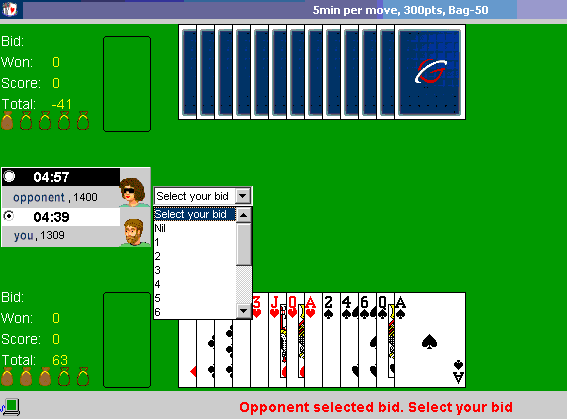

If the team doesn't reach their bid, then they lose that number of points times ten. If the partnership manages to make the number of tricks they bid, they score 10 points for each successful trick. The rules of spades govern the bidding, which is the essence for scoring in the game. That's just the way the game goes and adds to the excitement. That equals 14 which means that one team will not reach their bid. Sometimes one team will bid seven tricks, and the other team will also bid seven tricks. Keep in mind that the bids don't have to equal 13. Both team-members add their bids together and that becomes the team's bid. For example, if a player has two aces, they may say that they bid two tricks. Each player declares how many tricks they think they are likely to win. The first part of the game is the bidding phase. Each new hand has a new dealer and if the dealer makes a mistake and misdeals, there is often a penalty of 50 points invoked. At the end of the dealing, each player should have 13 cards. The whole deck of 52 playing cards is dealt out. The rules for spades call for four players playing in pairs and the partners sit across from each other. While the rules of spades for playing are very simple, the scoring can become quite tricky. People who play Whist or Hearts will enjoy spades games, as the actual play is identical to these games. A game can take up to an hour depending on the aggressiveness of the players and the speed of play.įans of bidding card games such as Bridge or Rook will see similarities in the rules for spades as the opening part of the game requires players to take guesses about how many tricks (or books) they’ll be able to take. Once the score is tallied after each hand, another deal begins.Average playing time: Each hand will take between five and ten minutes, depending on the bidding. Once 10 sandbags are reached, the team looses 100 points and starts over with 0 sandbags again. When either of these are not met, the team will get -100 and -200 points respectively. If a nil is bid and met, the team gets an additional 100 points. If a bid is not met, each trick in the bid is worth -10 points. If the bid for a team is met, each trick counts 10 points, with any additional tricks (sandbags) worth 1 point.
RULES OF SPADES CARDS FULL
Once the full hand has been played, the game is scored. Spades cannot lead a trick until they have been broken in another trick or if that is the only suit the lead player has left in their hand. The winner of the trick leads the next trick. If a trick contains a spade, the highest spade wins. If a trick is played without a spade, the highest lead suit card takes the trick. Moving clockwise, each player plays a card to follow suit, unless they do not have the suit, in which they can play any card in their hand. The Spades game begins gameplay with the player to the left of the dealer, who can play any card other than a Spade.



The payout will be higher if you achieve it, but the loss even greater if you don't - so bid this at your own risk! Teams must reach the total number of tricks they have bid together in order to get a positive score. If you bid a Blind Nil, you must bid a 0 without seeing your cards. The table then enters into the bidding phase where they estimate the number of tricks they can take with the hand they have been dealt. Spades is a game of trumps, where all spades are the best cards in the game and will beat all other suits.Įach hand begins with all 52 cards being dealt to the players. The version of 24/7 Spades is the most popular and is played with four Spades players in a team format, where players across the table are considered teammates. Spades is played with a basic set of 52 cards and card value ranks from 2, the lowest, to Ace, the highest. Spades is a casual card game developed in the 1930's in the USA.


 0 kommentar(er)
0 kommentar(er)
